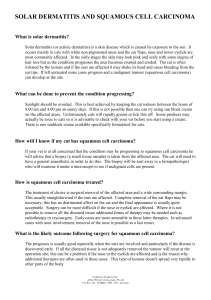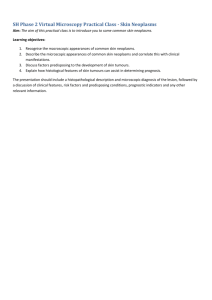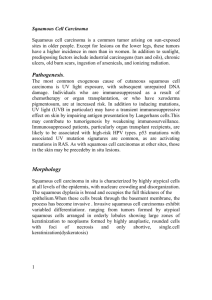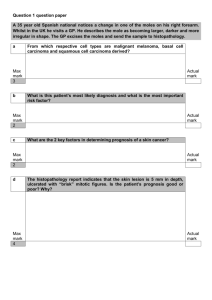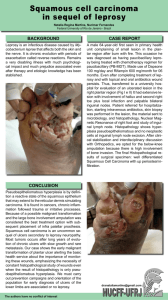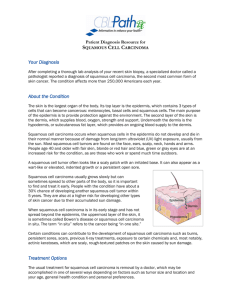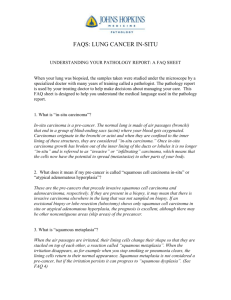DISCUSSION & REVIEW OF LITERATURE
advertisement
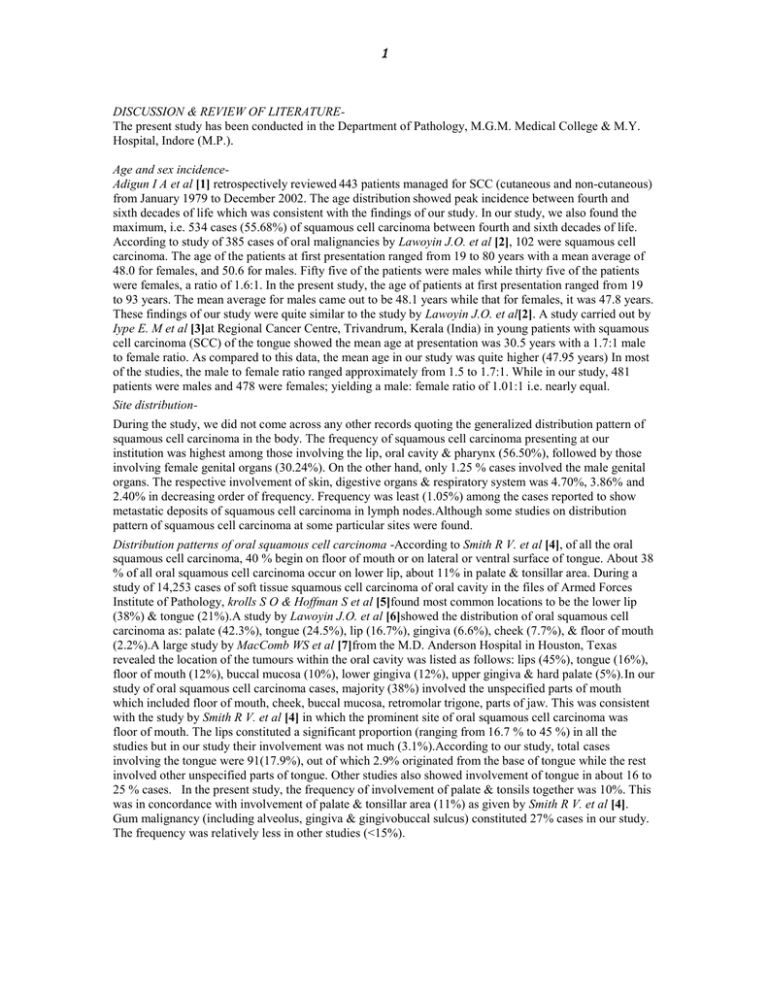
1 DISCUSSION & REVIEW OF LITERATUREThe present study has been conducted in the Department of Pathology, M.G.M. Medical College & M.Y. Hospital, Indore (M.P.). Age and sex incidenceAdigun I A et al [1] retrospectively reviewed 443 patients managed for SCC (cutaneous and non-cutaneous) from January 1979 to December 2002. The age distribution showed peak incidence between fourth and sixth decades of life which was consistent with the findings of our study. In our study, we also found the maximum, i.e. 534 cases (55.68%) of squamous cell carcinoma between fourth and sixth decades of life. According to study of 385 cases of oral malignancies by Lawoyin J.O. et al [2], 102 were squamous cell carcinoma. The age of the patients at first presentation ranged from 19 to 80 years with a mean average of 48.0 for females, and 50.6 for males. Fifty five of the patients were males while thirty five of the patients were females, a ratio of 1.6:1. In the present study, the age of patients at first presentation ranged from 19 to 93 years. The mean average for males came out to be 48.1 years while that for females, it was 47.8 years. These findings of our study were quite similar to the study by Lawoyin J.O. et al[2]. A study carried out by Iype E. M et al [3]at Regional Cancer Centre, Trivandrum, Kerala (India) in young patients with squamous cell carcinoma (SCC) of the tongue showed the mean age at presentation was 30.5 years with a 1.7:1 male to female ratio. As compared to this data, the mean age in our study was quite higher (47.95 years) In most of the studies, the male to female ratio ranged approximately from 1.5 to 1.7:1. While in our study, 481 patients were males and 478 were females; yielding a male: female ratio of 1.01:1 i.e. nearly equal. Site distributionDuring the study, we did not come across any other records quoting the generalized distribution pattern of squamous cell carcinoma in the body. The frequency of squamous cell carcinoma presenting at our institution was highest among those involving the lip, oral cavity & pharynx (56.50%), followed by those involving female genital organs (30.24%). On the other hand, only 1.25 % cases involved the male genital organs. The respective involvement of skin, digestive organs & respiratory system was 4.70%, 3.86% and 2.40% in decreasing order of frequency. Frequency was least (1.05%) among the cases reported to show metastatic deposits of squamous cell carcinoma in lymph nodes.Although some studies on distribution pattern of squamous cell carcinoma at some particular sites were found. Distribution patterns of oral squamous cell carcinoma -According to Smith R V. et al [4], of all the oral squamous cell carcinoma, 40 % begin on floor of mouth or on lateral or ventral surface of tongue. About 38 % of all oral squamous cell carcinoma occur on lower lip, about 11% in palate & tonsillar area. During a study of 14,253 cases of soft tissue squamous cell carcinoma of oral cavity in the files of Armed Forces Institute of Pathology, krolls S O & Hoffman S et al [5]found most common locations to be the lower lip (38%) & tongue (21%).A study by Lawoyin J.O. et al [6]showed the distribution of oral squamous cell carcinoma as: palate (42.3%), tongue (24.5%), lip (16.7%), gingiva (6.6%), cheek (7.7%), & floor of mouth (2.2%).A large study by MacComb WS et al [7]from the M.D. Anderson Hospital in Houston, Texas revealed the location of the tumours within the oral cavity was listed as follows: lips (45%), tongue (16%), floor of mouth (12%), buccal mucosa (10%), lower gingiva (12%), upper gingiva & hard palate (5%).In our study of oral squamous cell carcinoma cases, majority (38%) involved the unspecified parts of mouth which included floor of mouth, cheek, buccal mucosa, retromolar trigone, parts of jaw. This was consistent with the study by Smith R V. et al [4] in which the prominent site of oral squamous cell carcinoma was floor of mouth. The lips constituted a significant proportion (ranging from 16.7 % to 45 %) in all the studies but in our study their involvement was not much (3.1%).According to our study, total cases involving the tongue were 91(17.9%), out of which 2.9% originated from the base of tongue while the rest involved other unspecified parts of tongue. Other studies also showed involvement of tongue in about 16 to 25 % cases. In the present study, the frequency of involvement of palate & tonsils together was 10%. This was in concordance with involvement of palate & tonsillar area (11%) as given by Smith R V. et al [4]. Gum malignancy (including alveolus, gingiva & gingivobuccal sulcus) constituted 27% cases in our study. The frequency was relatively less in other studies (<15%). 2 Distribution patterns of squamous cell carcinoma of larynx–A retrospective analysis of 690 cases of carcinoma larynx presenting to Nehru Hospital, Postgraduate Institute of Medical Education & Research , Chandigarh between year1988 to 1997was conducted by Bakshi J et al[8]. Majority of the tumours were squamous cell carcinoma of which maximum involved supraglottis (55.94%) followed in decreasing order of frequency by glottis (17.3%), transglottis (13.04%) & subglottis (03.62%).While our study constituted a relatively small proportion of squamous cell carcinoma of larynx, just 20 out of 959 with cases involving the supraglottis constituting 15%. The highest numbers of cases in our study were those involving the epiglottis (30%), closely followed by unspecified parts of larynx (25%). Subglottis was involved in 10 % cases in our study with involvement of ventricular bands & arytenoids in the same proportion. Distribution patterns of squamous cell carcinoma of skin– In a study on skin cancer incidences over a 15year period (1987-2001) by Mohammad Taghi Noorbala et al in Yazd (Iran) [9], the frequency distribution of squamous cell carcinoma in the facial area alone comprises 71.7 % of all cases. Overall, 92 % of all skin cancers occurred in the face, head and neck regions. In our study also, the highest percentage (70%) of cases was constituted by the head and neck out of which 34% were from facial area. Another retrospective population based Swedish cohort study was carried out by Bernt Lindelof et al [10]to establish the anatomical site distribution of cutaneous squamous cell carcinoma in organ transplant recipients (OTRs) with regard to age & sex. The head & neck were the predominant sites in male patients, & the trunk was the predominant site in female patients. The most common site in younger patients was the chest; & in older patients, the face. The ear was a common site in male patients, but in contrast, no tumours were located there in female patients. In the present study, overall incidence of squamous cell carcinoma was higher in males. Our study showed male predominance at head and neck region as well trunk. Similarly, involvement of ear was there in males only while no such case was reported in females. During the study we encountered squamous cell carcinoma affecting the skin of lower limbs (13%) more frequently as compared to the upper limbs (4%). The respective frequency of squamous cell carcinoma involving skin of axilla, trunk and inguinal region was 7%, 4% and 2%. ICD-O: Morphological and topographical categoriesDuring the present study, we did not come across any other such study classifying squamous cell carcinoma into ICD-O categories according to the morphology & topography. A) Topographical distributionIn our study, we encountered the maximum number of cases (26.07%) of squamous cell carcinoma belonging to ICD-O category C-53 i.e. cervix. The next was category C-06 i.e. parts of mouth, unspecified with its frequency being 19.08%. Squamous cell carcinoma of anal canal (C-21), pyriform sinus (C-12), Bronchus & lung (C-34) and vulva (C-51) individually constituted <1% cases, with least number of cases (0.1%) being that of vulva. B) Morphological distributionMost frequently encountered category among the studied cases was that of Squamous cell carcinoma, keratinizing (35.2%). This was followed in decreasing order of frequency by Squamous cell carcinoma, with horn formation (20.8%) & Squamous cell carcinoma, clear cell (13.5%). Rest of the categories individually constituted <10% cases. Out of 959, only 10 cases (1.0%) could be categorized into Squamous cell carcinoma, metastatic. 3 SUMMARY & CONCLUSIONThus, in present study we came across the topographical and morphological spectrum of squamous cell carcinoma presenting at our institution. Maximum number of cases encountered involved the oral cavity, with predominant involvement of males, emphasizing the role of tobacco chewing (a prevalent practice in this particular geographical area) as an important predisposing factor. Maximum number of cases of squamous cell carcinoma of skin involved the sun exposed areas i.e. head and neck area including the face. This implicated the role of UV light exposure and tropical climate in the pathogenesis. The predominant ICD-O topographical category was that of squamous cell carcinoma of cervix. Majority of the females affected were >45 years of age. Morphologically, the spectrum at our institution showed maximum cases belonging to ICD-O category- Squamous cell carcinoma, keratinizing. This morphological type is usually considered to be well differentiated and has a good prognosis. As far as the behaviour pattern of the squamous cell carcinoma was concerned, most of the cases in our study were invasive types. Only 10 cases out of 959 were in-situ. This may demand better clinical vigilance of the premalignant lesions in early stages. So, through this study, we were able to study the present spectrum of squamous cell carcinoma at our institution. With this study, relevant data of squamous cell carcinoma for years 2007 and 2008, as per the requirements of Cancer Registry Programme & ICD-O has been compiled & analyzed. 4 REFERENCES[1] Adigun I.A et al.Clinico-pathological patterns of squamous cell carcinoma in Nigeria. Tropical Doctor 2006;36:157-158 [2] Lawoyin J.O et al.Intra-oral squamous cell carcinoma in Ibadan: A review of 90 cases.OdontoStomatologie Tropicale; 13-15. [3] Iype E.M et al .Squamous cell carcinoma of tongue among young Indian adults. JournalNeoplasia, July 2001, 3(4):273-77 [4] Smith R.V et al. Intraoral squamous cell carcinoma; The Merck manual of patient symptoms,2008 ) [5] Krolls S.O , Hoffmann S, Squamous cell carcinoma of oral soft tissues: a statistical analysis of 14,253 cases by age, sex & race of patients. J Am Dent Assoc, 92:571, 1976 [6] Lawoyin J.O. et al.Intra-oral squamous cell carcinoma in Ibadan: A review of 90 cases.Odonto-Stomatologie Tropicale; 13-15. [7] MacComb WS, Fletcher GH, Healey JE. Intraoral cavity. Cancer of Head & neck.Baltimore,1967, The Williams &Wilkins Co.,pg-89-151. [8] Bakshi J et al.Survival patterns in treated cases of carcinoma larynx in North India: A 10-year follow up study. Indian Journal of otolaryngology & Head and neck surgery,Vol.57, No.2, AprilJune-2005. [9] Mohammad Taghi Noorbala et al. Analysis of 15 years of skin cancer in central Iran (Yazd). Dermatology Online Journal 2007, vol 13 (4): 1 [10] Bernt Lindelof et al.Cutaneous squamous cell carcinoma in organ transplant recipients- A study of Swedish cohort with regard to tumour site. Arch Dermatology.2003; 141:447-451
